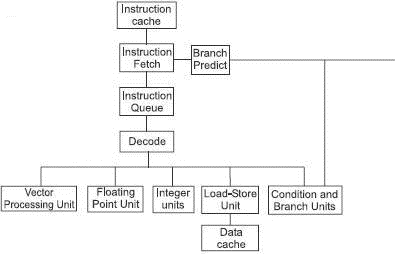Книга: Introduction to Microprocessors and Microcontrollers
PowerPC 970
PowerPC 970
A large number of PowerPCs have continued to power the Apple-Mac and IBM desktops and, in addition, support both the UNIX and Linux operating systems.
The latest offering is the 970 with its 52 million transistors started life as a 1.8 GHz device and has now progressed to 2.0 GHz. This may appear slow but it has compensating attributes such as its 900 MHz bus as opposed to the 533 MHz bus of the Pentium 4.
It is a 64-bit micro so it handles data in 64-bit chunks but remains compatible with earlier 32-bit designs. It has two level 1 caches, one for instructions at 64 kB and a data cache of 32 kB, which are somewhat larger that the Intel product but both companies use a level 2 cache of 512 kB.
As memory size is continuing to increase with each design, the size of memory that can be directly accessed increases with the move to 64-bit processing. The Pentium 4 can access 40 GB of memory, which seems excessively large at the moment but there was a time when 4 MB was something to wonder at. The PowerPC 970 can handle memory of Star Trek proportions measured in terabytes (thousands of Gigs).
Table 13.1 Cache sizes
| L1 Instruction | L1 Data | L2 cache | |
|---|---|---|---|
| PowerPC 970 | 64 kB | 32 kB | 512 kB |
| Pentium 4 | It’s a secret | 8 kB | 512 kB |
For maximum microprocessor speed we need a high clock speed combined with the maximum use being made of every part of the microprocessor. The early 8-bit microprocessors would accept the first instruction and it would pass through the microprocessor being decoded, then acted upon, then having the results stored before it considered the next instruction. This meant that each bit of the micro was doing nothing for much of the time.
Modern micros load many instructions at the same time and split up the tasks so that as many as possible can be carried out at the same time to have the minimum time wastage.
As with the Pentium 4, the PPC970 makes use of level 1 caches that, as is now common, are split into an Instruction cache and a Data cache. There is also a level 2 cache and an external level 3 cache.
Loading the instructions
The instructions pour down from the Instruction cache at a maximum rate of eight per cycle, though five is a more likely overall figure. But this is still fast.
The PP970 uses a very long pipeline and can be handling up to 200 instructions simultaneously. The price of such a long pipeline is that we must be careful to ensure that it is filled with the most useful instructions and hence we need to back it up with very effective branch prediction techniques.
Branch prediction
To obtain the maximum possible speed, the PP970 has devoted a great deal of resources into its branch prediction. As the instructions are loaded, the branch prediction circuitry scans the incoming instruction looking for branch instructions. Every time we meet a branch instruction that offers a choice of outcome the branch will have to be accepted or rejected.
The 970 has two branch prediction methods. The first is very similar to that used in the Pentium 4 and, to over simplify the situation, it follows the same sort of reasoning as we often adopt in everyday life. If it usually happens, it is most likely to happen again. The 970 keeps a record of the previous 16384 branches in its BHT (Branch History Table) to see how often each choice was made and then this information is further sorted by a prediction program before it comes to a final decision.
The second method involves a similar sized table called a Global Predictor. This method also comes up with a final go/no go for the branch but it decides by generating an 11-bit vector that stores the actual execution path taken by the previous eleven fetch groups leading up to the branch.
So there are two independent mechanisms that make a decision as to whether the branch should be taken. If they disagree, we need a referee. This job is performed by a ‘Selector Table’ that stores the success rate for each of the two previous methods for each particular branch. It then makes the final decision – and it is said (by IBM) to be very successful, which it probably is.
Handling the instructions
Having combined the incoming instruction stream from the Instruction cache with the information from the Branch predict, the instruction are queued and passed to the Decode, Crack and Group Formation Unit. At this stage, in order to keep the instruction handling speed at a maximum, this unit takes the instruction codes from the Instruction cache, decodes them and cracks them into their component parts called Internal Operations (IOPs). These very small but simple tasks are passed out to specialized units like the five blocks shown along the bottom of Figure 13.5.

Figure 13.5 The PowerPC 970
The IOPs are executed in whatever order that will result in the fastest throughput and to reduce the complexity of keeping track of the execution of each and every one, they are organized in groups of five and then the groups are tracked.
Of the final row shown, there are the arithmetically based block that handle the vectors, floating point and integer calculations, the load-store that handles the transfer of data to the memory via the second level cache and finally the feedback path for the branch prediction information.




